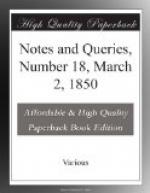With reference to the query regarding the word Pokership (No. 12. p. 185.), I would observe, that the word is correctly copied from the grant, and that it was so spelt in all the previous grants that I have been able to refer to. As to the meaning of the word, I am of the opinion that it is intended to express the office of keeping the hogs in the forest, i.e. Porcarius. Pokership was probably spelt in early times Pawkership, from Pawn, I apprehend; subsequently it was either spelt or pronounced Paukership or Pokership. In corroboration of this view, I would mention, that on referring to the Pipe Roll, 6 John, county of Hereford, the following will be found:—“Hubert de Burgo, Et i libae const. Parcario de heford, xxxs. vd.” If, however, Parkership be deemed the more correct reading, still it does not of necessity apply to the custody of a park; it might have denoted the pound-keeper, for, in matters relating to manors, parcus means a pound.
With respect to the query about Gib Cat, you will find the subject treated on largely in the Etymologicon—I may say, exhausted.
By the bye, there can be no doubt that Emerod means Emerald; formerly Emerald would be spelt Emeraud, and the transition is natural to Emerode—Emerod. With regard to the supposed size being an objection to this reading, it will be found that anciently the matrix of the Emerald, which is tinged green, went by the name of the more valuable jewel.
T.R.F.
Spring Gardens, Feb. 1850.
Golden Frog (No. 14. p. 214.).—Sir John Poley’s frog may have been a device alluding to his name; I imagine that Poley is an appelative of frogs. I find in Halliwell’s Dict. of Archaic Words, “Pollywig,” and in Jamieson’s Scottish Dictionary, “Powlick,” both meaning tadpole, and both diminutive forms; and Rowley Poley is closely (though not very logically) connected with the frog who would a-wooing go. The word has probably the same root as poole, puddle, &c.
R.R.
Madoc.—In addition to what is stated (No. 4. p. 56.) on this subject, may be noted, that in the MS. Add. 14,957. British Museum, fol. 149., is a letter from Dr. David Samwell to the Gwyneddigion Society, dated 23rd March, 1791, in which he states, that the result of an interview, held by himself and William Owen with General Bowles, “places the existence of a race of Welsh Indians beyond all matter of doubt.” This race is identified with Padongas on the Missouri, who are said to be of a different complexion from the other Indian races, and to have books, which they were not able to read. Is this information to be depended on or not?
F.M.




